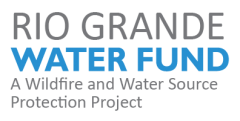Comprehensive Plan
The Rio Grande Water Fund: Comprehensive Plan for Wildfire and Water Source Protection is the culmination of a collaborative partnership among more than 40 organizations and agencies and more than two years of research and planning guided by a diverse advisory board. The Comprehensive Plan uses the best available data to describe the current wildfire threat to water sources and forested watersheds, setting forth a path for New Mexico’s future water security. The focus is on water as the primary resource that people value, and that originates in forested headwaters at high risk of damaging wildfire.
New Mexico must act now to protect our watersheds and water supply. With every year that goes by without a large-scale solution, more forested acres burn too hot jeopardizing more critical water sources, threatening communities and putting other natural values at risk. A coordinated, leveraged, multi-partner effort is needed to scale up restoration. This Comprehensive Plan provides a blueprint for action. This plan includes an introduction and analysis of water security threats, a vision for the future, summaries of study results that will guide water fund investments and a clear path forward to securing New Mexico’s water for the future.
Monitoring and Adaptive Management Plan
The Water Fund’s Monitoring Working Group completed a draft of the monitoring plan in March 2014; the plan was briefly summarized in the Rio Grande Water Fund’s Comprehensive Plan (TNC 2014). Since that time, we decided to revisit and revise the plan for two reasons.
First, given the Water Fund’s objective of protecting the quality of Rio Grande water, we wanted to expand monitoring of water quality directly or of indicators that indirectly relate to water quality. In the draft plan, there was only a single monitoring metric that addressed the question of whether large-scale restoration activities in the watershed were leading to an improvement in water quality. To this end, we received a contract from the Ciudad Soil & Water Conservation District to evaluate existing monitoring measures for water quality and modify the monitoring plan to incorporate these measures as needed. This iteration of the monitoring plan has six metrics that directly or indirectly related to water quality.
Second, given the monitoring plan’s objective of using monitoring data to enable corrections to management strategies, we revised the plan to create a framework that would facilitate adaptive management.
